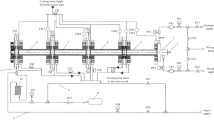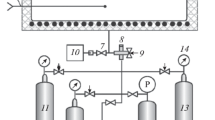Abstract
The flammability limits and burning velocity of hydrogen-air mixtures with diluent (nitrogen, steam) have been studied experimentally at temperatures up to 250°C and pressures up to 4 MPa. It has been observed that the flammability limits are practically independent of pressure within 2–4 MPa. It is shown that nitrogen and steam as diluents have quantitatively and qualitatively different effects on the burning velocity of stoichiometric hydrogen-air mixtures. The effects observed are interpreted qualitatively.
Similar content being viewed by others
References
H. F. Goward and G. W. Jones, Limits of Flammability of Gases and Vapors, Bulletin 503, Bureau of Mines, Washington (1952).
T. Mitani and F. A. Williams, “Study of cellular flames in hydrogen-oxygen-nitrogen mixtures,” Combust. Flame,39, No. 2, 169–190 (1980).
V. I. Makeev, A. A. Ponomarev, V. V. Stroganov, et al., “Combustion characteristics and transition to detonation of water-sprayed gas mixtures,” Problems of Combustion and Detonation, Proceedings of the Ninth All-Union Symp. on Combustion and Explosion [in Russian], Inst. Khim. Fiz. (OIKhF), Chernogolvka (1989), pp. 50–52.
V. Ya. Basevich, A. A. Belyaev, B. V. Novozhilov, and V. S. Posvyanskii, “Numerical study of laminar flame propagation for determination of the chemical and physical characteristics of combustible mixtures,” Combustion of Heterogeneous and Gas Systems, Proceedings of the Eighth All-Union Symp. Combustion and Explosion, Inst. Khim. Fiz. (OIKhF), Chernogolovka (1986), pp. 8–11.
D. D. S. Liu and R. Mac Farlane, “Laminar burning velocities of hydrogen-air and hydrogen-air-steam flames,” Combust. Flame,49, No. 1/3, 59–71 (1983).
V. S. Babkin and A. V. V'yun, “Inhibition of hydrogen-air flames under high pressures,” Fiz. Goreniya Vzryva,17, No. 5, 8–13 (1981).
F. Behrendt and J. Warnatz, “The dependence of flame propagation velocity in H2-O2-N2 mixtures on temperature, pressure, and initial composition,” Int. J. Hydrogen Energy,10, No. 11, 749–755 (1985).
Yu. N. Shebeko, A. Ya. Korolchenko, S. G. Tsarichenko, V. Yu. Navtsenya, and V. L. Malkin, “The influence of initial pressure and temperature on combustion characteristics of hydrogen mixtures,” Fiz. Goreniya Vzryva,25, No. 3, 32–36 (1989).
Yu. N. Shebeko, S. G. Tsarichenko, A. Ya. Korolchenko, and A. N. Erofeev, “The combustion characteristics of hydrogen-methane-air mixtures in a closed reactor,” Fiz. Goreniya Vzryva,27, No. 6, 52–56 (1991).
T. Iijima and T. Takeno, “Effects of temperature and pressure on burning velocity,” Combust. Flame,65, No. 1, 35–43 (1986).
G. B. Holmstedt, “The upper limit of flammability of hydrogen in air, oxygen, and oxygen-inert mixtures at elevated pressures,” ibid.,17, No. 3, 295–301 (1971).
S. M. Kogarko and O. B. Ryabikov, “Determination of the flammability limits of hydrogen-oxygen mixtures in the range of initial pressures from 1 to 100 atm,” Fiz. Goreniya Vzryva,6, No. 3, 406–407 (1970).
S. M. Kogarko, A. G. Lyamin, O. E. Popov, A. Yu. Kusharin, and A. V. Dubrovin, “Determination of flammability limits of stoichiometric oxyhydrogen mixtures with steam,” in: Hydrogen Behavior and Control and Related Containment Loading Aspects, IAEA, Vienna (1984), pp. 37–41.
B. Lewis and G. Elbe, Combustion, Flame, and Explosions in Gases [Russian translation], Mir, Moscow (1968).
V. V. Mol'kov, V. N. Bukharov, V. S. Babkin, and A. N. Baratov, “Determination of burning velocity by the inverseproblem method in a constant-volume bomb,” in: Fire Prevention [in Russian], VNIIPO, Moscow (1986), pp. 37–48.
GOST 12.1.044-89 (All-Union State Standard), SSBT, Fire and Explosion Hazard of Substances and Materials. Range of Characteristics and Methods of Their Determination [in Russian], Gosstandart, Moscow (1990).
S. G. Tsarichenko, V. Yu. Navtsenya, Yu. N. Shebeko, and S. M. Lashkin, “Stands for investigation of combustible and explosive gas-vapor mixtures under elevated pressures and temperatures,” in: Fire Hazard of Substances and Materials Employed in Industry [in Russian], VNIIPO, Moscow (1987), pp. 3–10.
S. G. Tsarichenko, Yu. N. Shebeko, A. V. Trunev, M. A. Serkin, and A. Yu. Kaplin, “Determination of flammability limits in hydrogen mixtures with inert retardants,” Khim. Promyshlennost, No. 10, 580–582 (1991).
V. V. Azatyan and A. A. Shavard, “Self-deceleration of hydrogen combustion and some problems of non-isothermie chain reactions,” Kinet. Katal.,22, No. 1, 101–106 (1981).
Additional information
Balashikha. Translated from Fizika Goreniya i Vzryva, Vol. 30, No. 1, pp. 16–19, January–February, 1994.
Rights and permissions
About this article
Cite this article
Shebeko, Y.N., Tsarichenko, S.G., Trunev, A.V. et al. Investigation of the combustion characteristics of H2-O2-N2-H2O mixtures under elevated pressures and temperatures. Combust Explos Shock Waves 30, 15–18 (1994). https://doi.org/10.1007/BF00787880
Received:
Issue Date:
DOI: https://doi.org/10.1007/BF00787880




